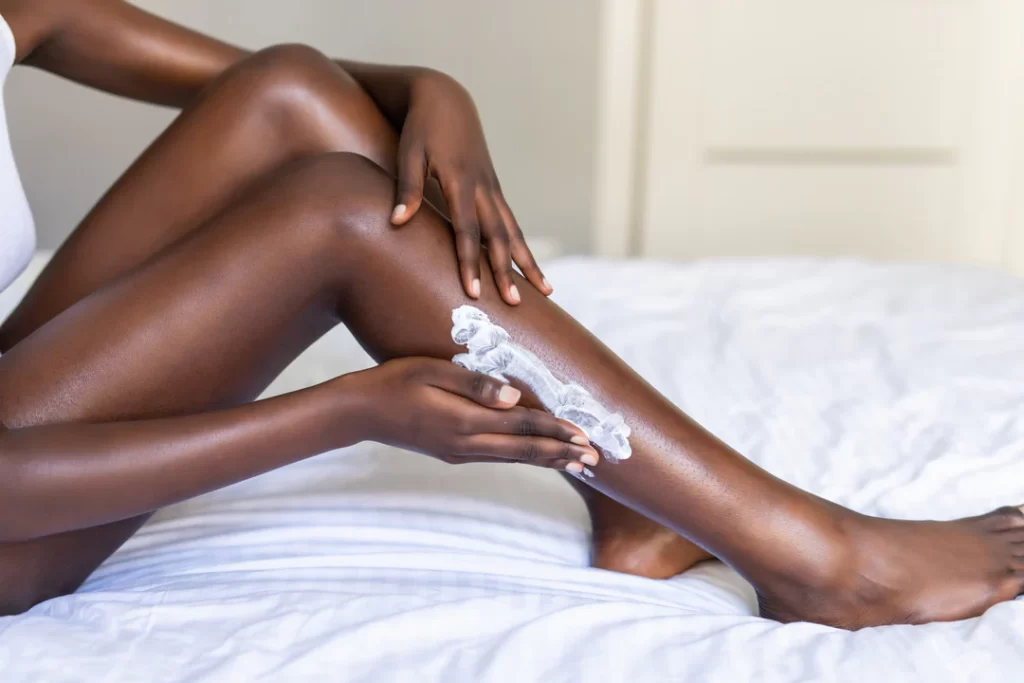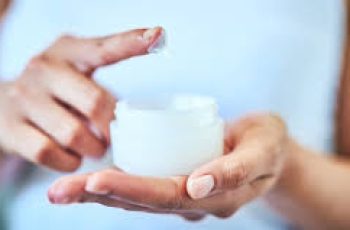
Can I use Hyaluronic Acid on my Arms and Legs?
Since the day hyaluronic acid made its way into our daily skincare routine, we have been obsessed ever since! Naturally occurring in the body as well as being derived from sugar cane, this clever ingredient has various benefits and abilities to hydrate the protective skin barrier ensuring the skin is fully protected from environmental aggressors. Not to mention how it target signs of dehydration reducing the appearance of fine lines and wrinkles. And those are only a couple of the benefits you can expect to see when using hyaluronic acid in your everyday skincare routine, you understand our obsession a little better now right?
The magic of hyaluronic acid doesn’t stop at skincare benefits, it is also praise for the impressive hydrating results you can expect to see when using it on the body too, so this leads me to finding out can you use hyaluronic acid on your arms and legs? Let’s dive right in and find out more.
Can you put hyaluronic acid on your body?
You can indeed, in fact, many skincare experts rave about the effects of using body gels, lotions, and creams enriched in hyaluronic acid can revive tried looking skin on the body, especially on areas that can become quite dry, such as arms, elbows, legs and knees. You’ll really notice a difference and improvement in the overall skin health if you find you have experienced sunburn or excessive sun exposure. This will often lead to the skin on the body and face feeling tight, dry, and uncomfortable. Be sure to take with you a body gel packed with hyaluronic acid on any tropical and warm holidays to keep your skin healthy, hydrated, and in its happiest state.
What skin type should use hyaluronic acid?
Hyaluronic acid is suitable for almost all skin types, this is because all skin types are likely to suffer from dehydration. Thanks to the humectant traits of HA, you’ll find it is able to draw in moisture surrounding the face and even the water content of skincare formulas can be locked into place. This leaves you with a plumped, hydrated, and youthful complexion. The main skin types that will gain optimal results are those who are dry and prone to flare-ups in certain conditions such as eczema, psoriasis, and even dryness from day-to-day exposure to central heating and harsh climates to name a few environmental aggressors. As for oily skin types, you’ll find that they also suffer from dehydration which not only leaves the skin barrier weakened to potential damage, but you’ll also find that signs of ageing, such as fine lines and wrinkles, become more noticeable.
Can you put hyaluronic acid on your hands?
Absolutely! Using a daily hand cream packed with hyaluronic acid, and SPF will ensure the skin on the hands are fully protected from damage with fine lines and areas of dryness combated, as well as a helpful boost in collagen giving them a replenished and youthful appearance.
Quite often our hands are the last thing we think of when it comes to self-care. But due to the fact they are continuously exposed to daily free radicals, such as UV rays and bad weather they are one of the first areas of your body that show signs of ageing, from fine lines and dark spots of pigmentation also called age spots.
What happens if you use too much hyaluronic acid?
Sadly, you can have too much of a good thing. You can indeed use too much hyaluronic acid and because of its hard-working humectant tendencies, you’ll be left with skin that feels thirstier. The reason for this is because hyaluronic acid never stops working at drawing in moisture from air around the face and other skincare products formulas. If HA (hyaluronic acid) finds there isn’t enough humidity in the air or product formulas, it will simply begin drawing moisture up from the lower layers of the skin which unintentionally prevents the skin from gaining the optimal results.
Is it OK to use hyaluronic acid every day?
Yep, you certainly can! In fact, it is strongly advised to use hyaluronic acid enriched products twice a day. To get the most out of it use it during your morning and evening routine by applying it onto freshly cleansed skin, preferably that is still slightly damp to kick start hyaluronic acid’s humectant traits. You’ll find that using serums enriched in hyaluronic acid will keep the skin barrier plumped and hydrated which will lead to any other products you apply to the face will be absorbed rapidly and leaving you with fast results.
Much like all skincare ingredients it is important that you ensure they are the best for you and your skin. Therefore, I suggest consulting with a doctor or dermatologist, as well as perform a patch test on the skin for 24 hours to avoid any unwanted reactions.
Does hyaluronic acid have side effects?
The short answer is, not really, this is because hyaluronic acid is generally considered very safe for almost all skin types to use. There have been very few reports about any side effects experienced from introducing hyaluronic acid into your daily skincare routine. Having said that, as I have already mentioned it is important to ensure you and your skin will benefit from this powerhouse ingredient in your routine.
Should I apply hyaluronic acid on wet skin?
Yes, because hyaluronic acid is a magnet for water it will thrive when it is applied to wet skin. Bearing in mind of course, that you wouldn’t want your skin to be too wet as this will prevent the skincare formula to absorb into the skin surface. As a rule, for skincare application, it is considered best to work your way from the thinnest formulas to thickest formulas. This is ideal for you to reap the rewards of serums enriched with hyaluronic acid that is applied after cleansing and exfoliating toners, but before thicker moisturisers.
So, there you have it, hopefully I have answered some if your questions about using hyaluronic acid on your arms and legs. Don’t forget if you have any more questions come and follow us in Instagram, you can find me in the DMs.
DQH Can I use salicylic acid first and then vitamin C?
It’s easy to create a skincare routine, but knowing how to use it is another thing entirely. In most cases, if you’re not getting the desired skin results, it could be due to the layering of conflicting ingredients. So, is it possible that salicylic acid and vitamin C are such ingredients? Or are these active ingredients the duo that’s been missing from your skincare routine? If you want answers, stick around because today we are going to explain the benefits of salicylic acid and vitamin C and how they can be used in your daily life.
What are the benefits of salicylic acid for skin?
Salicylic acid is one of the most commonly used beta hydroxy acids and is favored by many people with oily, acne-prone skin. This acid is derived from willow bark, and unlike its water-soluble relatives (called alpha-hydroxy acids), salicylic acid is oil-soluble, which means it can penetrate deeper into the lower layers of the skin. Once it reaches the lower layers, it can help unclog pores of excess sebum, dirt, bacteria, debris, and impurities. This results in clearer skin tones and greater definition.
Not only does salicylic acid benefit the underlying layers, but the outer surface of the skin benefits as well. When applied to the skin, salicylic acid removes the buildup of dead skin cells. This is accomplished by breaking the bonds that hold dead cells to the surface. Over time, this can cause the complexion to look dull and prone to acne, blackheads, and other blemishes.
If you’d like to learn more about salicylic acid and how it can improve your skin, check out this dedicated blog post from a beauty insider.
What are the benefits of vitamin C for skin?
Vitamin C is considered one of the most powerful antioxidants, which means it is very effective at fighting free radicals and preventing them from causing further skin damage. Examples of free radicals include pollution, central heating, UV rays and harsh climate. They attack proteins, fats and cell membranes as soon as they come into contact with the skin, causing signs of premature aging such as fine lines and wrinkles as well as hyperpigmentation, flaky patches of skin and loss of elasticity.
Many people usually prefer to use vitamin C in their morning routine as this ingredient gives the complexion a radiant glow. You’ll also find that vitamin C can target areas of hyperpigmentation, plumping the skin and reducing the appearance of fine lines and wrinkles.
The thing about vitamin C is that there are a lot of outdated studies going back to the 1950s that describe vitamin C as an unstable skin component. Thanks to improvements in modern technology, this is no longer the case as all products now contain a stable form of vitamin C.
Visit The Beauty Insider to learn more about vitamin C. So please check out our blog post.
Can I use salicylic acid first and then vitamin C?
Yes, you absolutely can. In fact, it’s thought that using salicylic acid before using vitamin C ensures it penetrates faster and works faster.
This is an efficient way to utilize two power sources, and the reason has to do with pH. For example, the skin’s natural pH is about 4.7, making it slightly acidic. Salicylic acid and vitamin C are also both acidic, and you’ll find that vitamin C is absorbed quickly into the skin. Therefore, using salicylic acid beforehand can increase the acidity of the skin and allow vitamin C to penetrate into the skin faster.
While this is considered an effective way to combine two powerful ingredients, you need to be aware of your skin type and how it reacts to certain active ingredients. Even people with perfect, normal skin can experience skin sensitivity and irritation. Therefore, always consult a doctor or dermatologist before using any new products on your skin.
It’s also important to follow skin application rules. In this case, you need to use the product correctly to ensure you get the best results for your skin. If you’re not sure what I mean, the basic rule for skin is to start with the thinnest consistency and work your way up to the thickest consistency. This prevents a barrier from forming on the surface, preventing other active ingredients from penetrating the skin.
Can I use salicylic acid at night and vitamin C in the morning?
Yes, absolutely, this is considered the most effective way to get returns without any adverse side effects. This is because there is enough time between applications to ensure that the skin’s pH levels return to balance.
You’ll also find that Vitamin C is rich in antioxidants and is perfect for use in the morning to ensure your skin is protected and looking its healthiest. Due to the small size of salicylic acid molecules, it is an acid that is able to reach the deepest parts of the skin. While this is effective at keeping skin clear, it also increases the risk of irritation and photosensitivity. Therefore, many people prefer to use powerful BHAs in their evening routine without exposure to UV rays, pollution, or harsh weather.
Warning: If you avoid using sunscreen every day, none of these ingredients will do what your skin needs. The combination of chemical peels and powerful ingredients increases the risk of further damage to the skin’s surface. Use SPF 50 every day to keep your skin protected and your lipid barrier healthy, even on cloudy days, keeping your skin in top condition.


